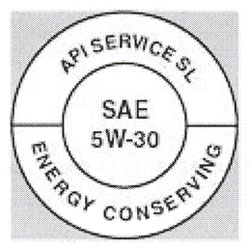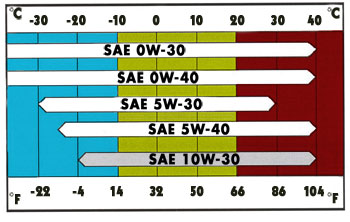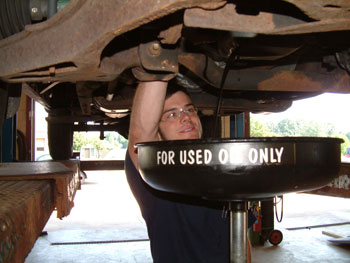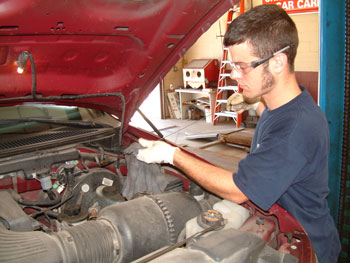Most people think motor oil is only a lubricant that reduces friction and wear inside an engine. But it also helps cool bearings, pistons and other parts, and helps prevent rust and corrosion. It also contains detergents that help keep the engine clean.
Motor oil is made up of various hydrocarbons refined from petroleum. The hydrocarbons are blended with other ingredients to create motor oils with unique properties for specific engine applications. Additives improve the lubricating qualities of the oil, reduce friction and extend the life of the oil and the engine.
 Rating System
Rating System
Motor oils must meet certain requirements set forth by the vehicle manufacturers and the American Petroleum Institute (API). The API “service rating” of an oil certifies that it meets specific OEM quality and performance standards. The service rating is shown in the API “Service Symbol Donut”on the product label. There may also be an “API Certified for Gasoline Engines” seal on the label.
The current service category rating for gasoline engines is “SM,” introduced in November 2004 for 2005 and newer engines. SM-rated oils along with the previous “SL” (2001) and “SJ” (1997) ratings, are backwards compatible and can be safely used in older engines.
For diesel engines, API has a separate rating system. The current category is “CI-4” (introduced in 2002 for newer diesels that have exhaust gas recirculation). The previous CH-4 (1998), CG-4 (1995) and CF-4 (1990), can all be used in older four-stroke diesel engines. CF-2 (1994) is the API classification for two-stroke diesels. API also gives oils an “Energy Conserving” rating if the oil meets certain criteria for reducing friction and oil consumption and for improving fuel economy.
Motor oils that meet the current API SM rating may also meet the International Lubricant Standardization and Approval Committee (ILSAC) “GF-4” specifications for North American and Asian vehicles. Meeting this specification is indicated on the label by the API Certification Mark, commonly referred to as the Starburst Symbol.
 Making the Grade
Making the Grade
Motor oils are also graded according to their “viscosity” (thickness). Viscosity refers to how easily oil pours at a specified temperature. Thinner oils have a water-like consistency and pour more easily at low temperatures and thicker oils have a more honey-like consistency. Thin is good for easier cold weather starting, reducing friction and improving fuel economy, while thick is better for maintaining film strength and oil pressure at high temperatures and loads.
The viscosity rating of a motor oil is determined in a laboratory using various test procedures. The viscosity of the oil is measured and given a number, which refers to the thickness of the oil (which some people call the “weight” of the oil, but has nothing to do with the oil’s actual weight in kilograms or ounces). The lower the viscosity rating, the thinner the oil and the higher the viscosity rating, the thicker the oil.
Viscosity ratings for commonly used motor oils typically range from zero up to 50. A “W” after the number stands for “Winter” grade oil, and represents the oil’s viscosity at zero degrees Fahrenheit. Low viscosity motor oils that pour easily at low temperatures typically have a “5W” or “10W” rating. There are also 15W and 20W grade motor oils.
Higher viscosity motor oils that are thicker and better suited for high temperature operation typically have an SAE 30, 40 or even 50 grade rating.
These numbers, by the way, are for “single” or “straight” weight oils. Such oils are no longer used in late model automotive engines, but may be required for use in some vintage and antique engines. Straight SAE 30 oil is often specified for small air-cooled engines in lawnmowers, garden tractors, portable generators and gas-powered chain saws.
Most modern motor oils are formulated from various base stock oils, which include both conventional and synthetic (polyalphaolefin) oils. Many 5W-30 conventional motor oils, for example, actually contain some synthetic base oil even though the product may not be marketed as a synthetic blend.
Blending various base stocks and grades of oil creates a “multi-viscosity” oil that has good cold-flow characteristics and good high temperature film strength. Then the various additives are blended in to complete the formulation.
Up to 25 percent of the contents in a quart of conventional oil is additive. In synthetic oil, less additives are needed (maybe only 12 to 15 percent). The additives include detergents, viscosity modifiers, friction modifiers, seal additives, anti-oxidants, anti-wear agents, corrosion inhibitors and pour depressants. Some racing oils typically have a higher dose of zinc to provide extra protection in high-revving, high-load applications.
Most vehicle manufacturers today specify 5W-30 or 10W-30 motor oil for year-round driving. Some also specify 5W-20. Many overhead cam engines require 5W-30 to speed lubrication to the camshaft and valvetrain components after a cold start. Refer to the vehicle manual for specific oil viscosity recommendations, or the markings on the oil filler cap or dipstick.
As mileage adds up and internal engine wear increases bearing clearances, switching to a slightly higher viscosity oil can prolong engine life, reduce noise and oil consumption (switching from say a 5W-30 to a 10W-30).
 Oil Life
Oil Life
Oil life depends on many factors including driving conditions (speed, load, idle time, etc.), environmental factors (temperature, humidity, airborne dirt) and engine wear. As the miles add up, motor oil loses its ability to perform and gets dirty. The additives wear out and the oil is no longer able to lubricate and protect like it did when it was new.
Short trips and stop-and-go driving (especially during cold weather or extremely hot weather) make the oil wear out more quickly. Many motorists think this kind of driving is “normal.” But it is actually “severe service,” so drivers should follow a severe service schedule. Severe service includes frequent trips under four miles, prolonged high speed driving during hot weather, towing a trailer and driving on dusty roads (gravel roads).
 Changing the oil and filter every 3,000 miles or six months, which ever comes first, provides the best all-round protection for the average driver. Some vehicle manufacturers recommend extended oil change intervals of up to 7,500 miles or more.
Changing the oil and filter every 3,000 miles or six months, which ever comes first, provides the best all-round protection for the average driver. Some vehicle manufacturers recommend extended oil change intervals of up to 7,500 miles or more.
But some have experienced oil sludging and expensive engine damage as a result of pushing the interval too far. Older high-mileage engines (over 75,000 miles) with worn rings and cylinders should have the oil changed at 3,000 miles. Special “high mileage” motor oils with extra wear additives and seal conditioners are a good choice for these applications.
Engines that are turbocharged or supercharged, as well as diesels, are also hard on the oil, so 3,000 miles oil changes are usually recommended for these applications, too.
Some late-model vehicles have no specific mileage recommendation for oil changes, but use an “oil reminder light” (not to be confused with the oil pressure warning light) to indicate when the oil should be changed. Be aware that these systems generally do not monitor oil condition or the oil level, but only estimate oil life based on hours of engine operation, temperature and miles driven.











